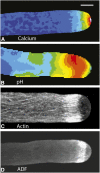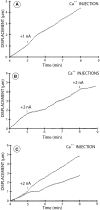The Cytoskeleton and Its Regulation by Calcium and Protons
- PMID: 26722019
- PMCID: PMC4704593
- DOI: 10.1104/pp.15.01506
The Cytoskeleton and Its Regulation by Calcium and Protons
Abstract
Calcium and protons exert control over the formation and activity of the cytoskeleton, usually by modulating an associated motor protein or one that affects the structural organization of the polymer.
Figures



Similar articles
-
Spatial control of cell expansion by the plant cytoskeleton.Annu Rev Cell Dev Biol. 2005;21:271-95. doi: 10.1146/annurev.cellbio.21.122303.114901. Annu Rev Cell Dev Biol. 2005. PMID: 16212496 Review.
-
How to scaffold the contractile ring for a safe cytokinesis - lessons from Anillin-related proteins.J Cell Sci. 2009 Apr 15;122(Pt 8):1071-9. doi: 10.1242/jcs.034785. J Cell Sci. 2009. PMID: 19339546 Review.
-
Involvement of microtubules and Rho pathway in TGF-beta1-induced lung vascular barrier dysfunction.J Cell Physiol. 2005 Sep;204(3):934-47. doi: 10.1002/jcp.20359. J Cell Physiol. 2005. PMID: 15828024
-
Adhesive interactions of N-cadherin limit the recruitment of microtubules to cell-cell contacts through organization of actomyosin.J Cell Sci. 2014 Apr 15;127(Pt 8):1660-71. doi: 10.1242/jcs.131284. Epub 2014 Feb 12. J Cell Sci. 2014. PMID: 24522194
-
Submembraneous microtubule cytoskeleton: regulation of ATPases by interaction with acetylated tubulin.FEBS J. 2008 Oct;275(19):4664-74. doi: 10.1111/j.1742-4658.2008.06615.x. Epub 2008 Aug 27. FEBS J. 2008. PMID: 18754775 Review.
Cited by
-
SUN11602, a bFGF mimetic, modulated neuroinflammation, apoptosis and calcium-binding proteins in an in vivo model of MPTP-induced nigrostriatal degeneration.J Neuroinflammation. 2022 May 7;19(1):107. doi: 10.1186/s12974-022-02457-3. J Neuroinflammation. 2022. PMID: 35526035 Free PMC article.
-
Formation and Maturation of the Phagosome: A Key Mechanism in Innate Immunity against Intracellular Bacterial Infection.Microorganisms. 2020 Aug 25;8(9):1298. doi: 10.3390/microorganisms8091298. Microorganisms. 2020. PMID: 32854338 Free PMC article. Review.
-
Cytoplasmic dynein1 intermediate-chain2 regulates cellular trafficking and physiopathological development in Magnaporthe oryzae.iScience. 2023 Feb 10;26(2):106050. doi: 10.1016/j.isci.2023.106050. eCollection 2023 Feb 17. iScience. 2023. PMID: 36866040 Free PMC article.
-
Transcriptome Analysis of Intrusively Growing Flax Fibers Isolated by Laser Microdissection.Sci Rep. 2018 Oct 1;8(1):14570. doi: 10.1038/s41598-018-32869-2. Sci Rep. 2018. PMID: 30275452 Free PMC article.
-
Simple Whole-Mount Staining Protocol of F-Actin for Studies of the Female Gametophyte in Agavoideae and Other Crassinucellate Ovules.Front Plant Sci. 2020 Apr 9;11:384. doi: 10.3389/fpls.2020.00384. eCollection 2020. Front Plant Sci. 2020. PMID: 32328076 Free PMC article.
References
-
- Abu-Abied M, Golomb L, Belausov E, Huang S, Geiger B, Kam Z, Staiger CJ, Sadot E (2006) Identification of plant cytoskeleton-interacting proteins by screening for actin stress fiber association in mammalian fibroblasts. Plant J 48: 367–379 - PubMed
-
- Alberts B, Johnson A, Lewis J, Raff M, Roberts K, Walter P (2008) Molecular Biology of the Cell, Ed 5. Garland Science, New York
-
- Allwood EG, Smertenko AP, Hussey PJ (2001) Phosphorylation of plant actin-depolymerising factor by calmodulin-like domain protein kinase. FEBS Lett 499: 97–100 - PubMed
Publication types
MeSH terms
Substances
LinkOut - more resources
Full Text Sources
Other Literature Sources

